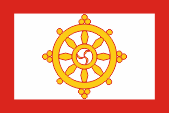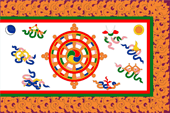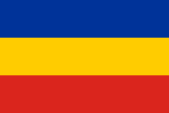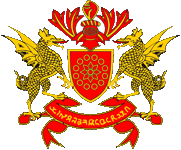Sikkim |
|
|
|
| Übersicht – Contents: | |
Diese Seite ist Teil des Projektes
Sikkim |
|
|
|
| Übersicht – Contents: | |
Flaggen – Flags: |
|
 |
1967–1975, Staats- und Maharadschaflagge – state flag and flag of the Maharajah, Seitenverhältnis – ratio = 2:3, Quelle/Source, nach/by: Flags of the World |
 |
1877–1967, Staats- und Maharadschaflagge – state flag and flag of the Maharajah, Quelle/Source, nach/by: Flags of the World |
 |
seit/since 1993, Flagge der Demokratischen Front von Sikkim – flag of the Sikkim Democratic Front, Quelle/Source, nach/by: Flags of the World   |
| Zentraler Bestandteil der Flagge von Sikkim war das "Tschakra", das bhuddistische "Rad der Lehre". Es bezieht sich auf Buddhas erste Predigt bei Benares, die als das "Ingangsetzen des Rades der Lehre" bezeichnet wurde. | Central element of the flag of Sikkim was the "Chakra", the Bhuddist "Wheel of Doctrine". It points out to the first sermon of Buddha near Benares Town, which was described as the "Turning on the Wheel of Doctrine". |
| Nach anderen Quellen ist das Rad in der Flagge ein Gebetsrad, ein sogenanntes "Khorlo". | Other sources tell that the wheel in de flag is a prayer wheel, a so-named "Khorlo". |
| Die bis 1967 gültige Flagge zeigte eine sehr üppige Ausgestaltung mit einem überbordenden Rand, die neben dem "Tschakra" einige religiöse Piktogramme zeigte. Wahrscheinlich wurde wegen der sehr schwierigen Vervielfältigung im Jahre 1967 ein einfacherers Design gewählt. Der Rand wurde einfarbig rot, die Piktogramme entfielen und das Rad wurde vom Design her überarbeitet. | The until
1967 valid flag showed a very abundant designing with a copious border and
next to the "Chakra" some religious pictograms. Probably was adoped a more simply design in 1967 because of the very difficult duplication. The border became single-coloured red, the pictograms were removed and the wheel was redesigned. |
| Mit dem Beitritt des Landes zur Republik Indien und der Abschaffung der Monarchie wurde auch die Flagge abgeschafft. Sikkim hat somit keine eigene Flagge mehr. Im Jahre 1994 kam die nationalistische Partei der Demokratischen Front von Sikkim an die Macht, und entsprechend eingestellte Bürger verwenden seit dem deren Parteiflagge als nationales Symbol. | With the
joining of Sikkim to the Republic of India and with the abolition of the
monarchy the flag was also abolished. Sikkim has in this way none own flag
anymore. In the year 1994 the nationalist party of the Democratic Front of Sikkim came into power and accordingly thinking citizens use since them its party-flag like a national symbol. |
| Quelle/Source: Wikipedia (DE), Flags of the World | |
Wappen – Coat of Arms: |
|
 |
Wappen von Sikkim – coat of arms of Sikkim Quelle/Source, nach/by: royalark.net |
| Das Wappen von Sikkim zeigt einen roten, golden umrandeten Schild. Auf dem Schild ein Kreis von zwölf goldenen Ringen und darin ein stilisierter, roter, golden umrandeter achtzackiger Stern. Oberhalb des Schildes ein roter Helm mit goldenem Visier, rot-goldenem Wulst und rot-goldenen Decken. Auf dem Helm eine rot-goldene Rosenknospe. Schildhalter sind zwei goldene Drachen. Unter dem Schild ein rotes Spruchband mit dem Namen des Landes. | The coat
of arms of Sikkim shows a red golden surrounded shield. On the shield a
circle of twelve golden rings and in it a stylized red and golden surrounded
eight-pointed star. Above the shield a red helmet with a golden visor, red-golden torus and red-golden blankets. Upon the helmet a red-golden rosebud. Supporters of the shield are two golden dragons. Below the shield and a red banner with the name of the country. |
| Die Farben Rot und Gold sind wahrscheinlich die Farben des Hauses Namgyal welches zwischen 1641 und 1975 das Land regierte. Die Farben Rot und Gelb könnten auch auf die Orden der Tibetischen Roten und Gelben Lamas zurückgehen. Die Roten Lamas hatten im Jahre 1641 den ersten Namgyal-König auf den Thron gesetzt. Die beiden Drachen sind Symbole des Glücks. | The
colours red and gold are probably the colours of the house of Namgyal which
ruled the country between 1641 and 1975. The colours red and yellow could also point out to the orders of the Tibetan red and yellow lamas. The red lamas enthroned in 1641 the first Namgyal-King. The both dragons are symbols of luck. |
| Das Wappen wird in ähnlicher Form noch immer von der Regierung Sikkims verwendet, obwohl außer dem ehemaligen Jammu und Kaschmir kein Bundesstaat Indiens ein eigenes Wappen oder eine eigene Flagge haben darf. | The coat of arms is still used in a similar form by the government of Sikkim, although no federal state in India – except the former Jammu and Kashmir – is allowed to have its own coat of arms or flag. |
| Quelle/Source: Wikipedia (EN), royalark.net | |
Landkarte – Map: |
|
|
|
|
| Zahlen und Fakten – Numbers and Facts: | |
|
|
|
|
|
|
|
|
|
|
|
|
|
|
|
|
|
|
|
|
|
| 13.
Jahrhundert · Besiedlung durch das Volk der Rong (später von den Nepalesen
Lepcha genannt), Entstehung von verschiedenen Rong-Fürstentümern 15. Jahrhundert · Einwanderung von Buthias (Tibeter), Einführung des Buddhismus 1641 · Die tibetische Namgyal-Dynastie begründet mit König Phuntsok Namgyal in der Ortschaft Yuksom die Herrschaft im Königreich Sikkim unter chinesischer Oberhoheit 1670 · die Hauptstadt wird nach Rabdentse verlegt 1700 · Invasion Bhutanesischer Truppen 1710 · Wiederherstellung der Souveränität Sikkims durch Tibetische Truppen 1710–1788 · Phase widerholter Überfälle Bhutanischer und vor allem Nepalesischer Truppen, die Hauptstadt Rabdentse wird zerstört 1788 · der König flieht nach Tibet 1791 · Chinesische und Tibetische Truppen marschieren zum Schutz Tibets und Sikkims in Nepal ein, Nepal kommt unter chinesische Oberhoheit, jedoch muss Sikkim einige Gebiete an Nepal abtreten, der König keht unter dem Schutz Tibetischer und Bhutanischer Truppen nach Sikkim zurück, Sikkim verbündet sich zum Schutz gegen Nepal mit den seit 1765 im benachberten Bengalen anwesenden Briten (British East India Company) 1813 · erneute Invasion Nepalesischer Truppen, Sikkim wird überrannt, aber der König kann sich jedoch in der Stadt Gangtok halten 1814 · der Gurkha-Krieg der Britischen Ostindienkompanie gegen Nepal endet mit der Niederlage Nepals 1817 · Vertrag von Titalia zwischen Sikkim und Britisch-Indien, Sikkim wird ein Vasallenstaat Britisch-Indiens unter Britischer Oberhoheit 1817 · Vertrag von Sugauli zwischen Sikkim und Nepal, Nepal tritt die 1791 erworbenen Gebiete wieder an Sikkim ab 1835 · Invasion Britischer Truppen, die Namgyal-Dynastie bleibt auf dem Thron, wird jedoch durch die Einsetzung eines britischen Gouverneurs entmachtet, Sikkim muss den Distrikt von Dardschiling (Darjeeling) an Britisch-Indien abtreten 1849 · Sikkim muss den Distrikt von Morang an Britisch-Indien abtreten 1889 · Einsetzung eines britischen Regenten für Sikkim 1890 · China erkennt die Britische Oberhoheit über Sikkim an, Nepalesen wandern in großen Zahlen ein und werden auf den Teeplantagen beschäftigt 1892 · der König kann dem Druck der Briten nicht mehr standhalten und flieht nach Tibet 1893 · Tibet wünscht die Wiederherstellung des Königtums in Sikkim und schickt den König nach Sikkim zurück, der König flieht nach Britisch-Indien 1895 · der König kehrt auf Wunsch der Briten wieder nach Sikkim zurück und übernimmt sein Amt ohne Einschränkungen, das Königtum wird wieder voll hergestellt, jedoch bleibt Sikkim britisches Protektorat und muss die britische Oberhoheit akzeptieren 15.08.1947 · Indien wird unabhängig, das Protektorat über Sikkim geht formell von Großbritannien auf Indien über 1949 · Indische Truppen schlagen einen Aufstand nieder 05.12.1950 · Vertrag von Gangtok, Erneuerung des Indischen Protektorats, in Gangtok wird ein Indischer Regent für Sikkim und Bhutan eingestzt 1970–1974 · gewaltsame ethnische Konflikte in Sikkim, Intervention der indischen Armee 1974 · Sikkim wird assoziierter Staat Indiens 10.04.1975 · der König wird auf Betreiben Indiens abgesetzt 16.05.1975 · Volksabstimmung, Sikkim wird 22. Bundesstaat Indiens, die Monarchie wird abgeschafft 2003 · China erkennt Sikkim als Teil Indiens an |
| 13th
century · settlement by the people of Rong (later named Lepcha by the
Nepalese), nascence of diverse Rong-Principalities 15th century · immigration of the Buthia (Tibetans), introduction of Buddhism 1641 · The Tibetan dynasty of Namgyal establishes with king Phuntsok Namgyal in the place Yuksom the reign in the Kingdom of Sikkim under Chinese supremacy 1670 · the capital becomes transfered to Rabdentse 1700 · invasion of Bhutanese troops 1710 · restoration of the sovereignty of Sikkim by Tibetan troops 1710–1788 · phase of frequent rides of Bhutanese and especially of Nepalese troops, the capital Rabdentse becomes ruined 1788 · the king flees to Tibet 1791 · Chinese and Tibetan troops invade Nepal to protect Tibet and Sikkim, Nepal comes under Chinese supremacy, but Sikkim has to cede some territories to Nepal, the king returns under protection of Tibetan and Bhutanese troops to Sikkim, Sikkim contacts to its own protection against Nepal to the since 1765 in the neighbouring Province of Bengalen present British (British East India Company) 1813 · once more invasion of Nepalese troops, Sikkim becomes overruned, but the king is able to withstand in Gangtok Town 1814 · the Gurkha War of the British East India Company against Nepal ends with the defeat of Nepal 1817 · Treaty of Titalia between Sikkim and British India, Sikkim becomes a vassal state of British India under British supremacy 1817 · Treaty of Sugauli between Sikkim and Nepal, Nepal cedes back to Sikkim the in 1791 earned territories 1835 · invasion of British troops, the dynasty of Namgyal stands on the throne but becomes displaced from the power by the appointment of a British governor, Sikkim has to cede the district of Darjeeling to British India 1849 · Sikkim has to cede the district of Morang to British India 1889 · appointment of a British regent for Sikkim 1890 · China recognizes the British supremacy over Sikkim, Nepalese immigrate in large numbers and become employed in the tea-plantations 1892 · the king is unable to withstand the pressure of the British and flees to Tibet 1893 · Tibet intends the restoration of the kingship in Sikkim and sends the king back to Sikkim, the king flees to British India 1895 · the king returns because of British wishes back to Sikkim and takes over his function without restrictions, the royalty becomes fully restored but Sikkim stands a British protectorate and has to accept the British supremacy 15th of August 1947 · India becomes independent, the protectorate over Sikkim becomes formally transfered from United Kingdom to India 1949 · Indian troops suppress a revolt 5th of December 1950 · Treaty of Gangtok, renewal of the Indian protectorate, in Gangtok becomes installed an Indian regent for Sikkim and Bhutan 1970–1974 · violent ethnic conflicts in Sikkim, intervention of the Indian army 1974 · Sikkim becomes an associated state of India 10th of April 1975 · the king becomes deposed because of Indian influence 16th of May 1975 · referendum, Sikkim becomes the 22nd federal state of India, the monarchy becomes abolished 2003 · China recognizes Sikkim as a part of India |
| Quelle/Source: Atlas zur Geschichte, Wikipedia (DE), royalark.net, World Statesmen |
| Der Name "Sikkim" hat seinen Ursprung in der Limboo-Sprache. Er setzt sich aus den Worten "Su" für "neu" und "Khyim" für "Palast" zusammen. Sikkim ist also der "Neue Palast". In den Tibetischen Sprachen wird Sikkim als "Depjong", "Demjong" oder auch "Denjong" bezeichnet, in der Chinesischen Sprache "Che Meng Hsiung". | The name
"Sikkim" has its roots in the Limboo-Language. It is composed by the words
"Su" standing for "new" and "Khyim" standing for "palace". Sikkim is in this
way the "New Palace". In the Tibetan languages Sikkim is called "Depjong", "Demjong" or even "Denjong", in Chinese language "Che Meng Hsiung". |
| Das ursprüngliche Volk von Sikkim sind die Rong. Auf Nepalesisch werden sie "Lepcha" genannt, was "Steinhaufen" heißt. Auf Grund der starken Nepalesischen Einwanderung seit 1890 sind die Rong inzwischen zu einer nationalen Minderheit geworden, was immer wieder zu ethnischen Konflikten führt. | The
pristine people of Sikkim are the Rong. In Nepalese they are called
"Lepcha", what means "cairn". Because of the potent Nepalese immigration since 1890 are the Rong meanwhile a national minority, what causes again and again ethnic conflicts. |
| Quelle/Source: royalark.net, Volker Preuß | |
|
Mit freundlicher Untersützung von: Kindly supported by: |
Wpantemister |